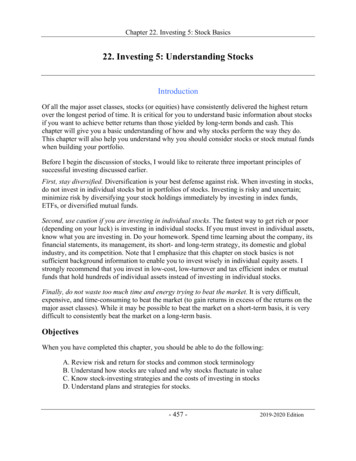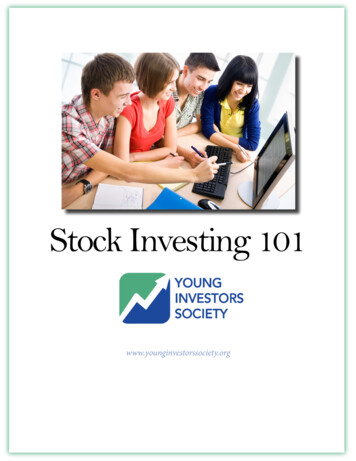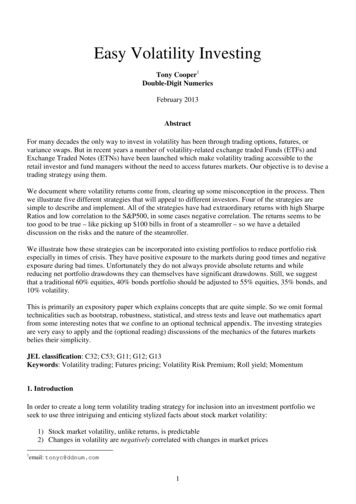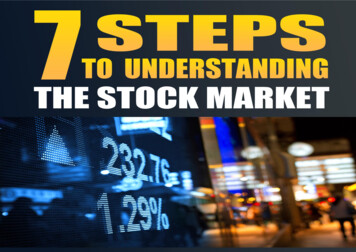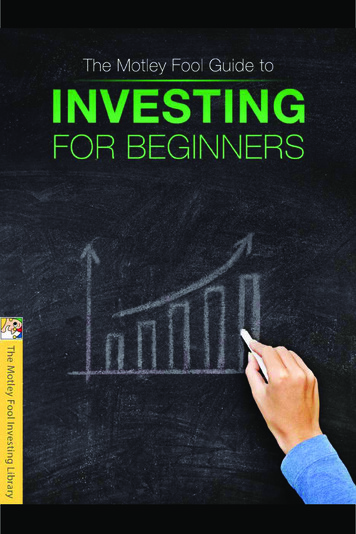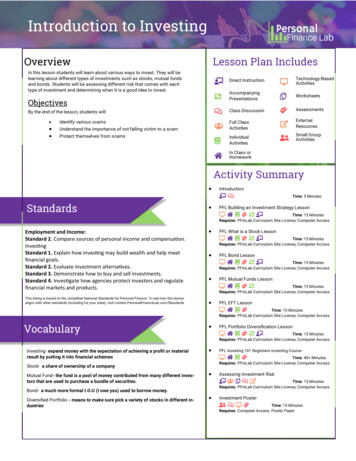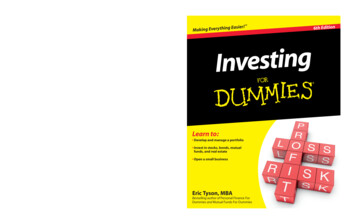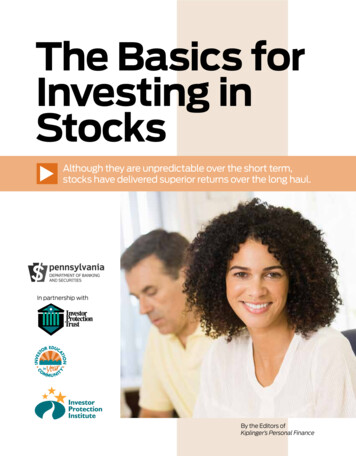
Transcription
The Basics forInvesting inStocksAlthough they are unpredictable over the short term,stocks have delivered superior returns over the long haul.In partnership withBy the Editors ofKiplinger’s Personal Finance
contentsTABLE OF CONTENTS1DIfferent flavors of stocks3The importance of diversificationThe Investor Protection Trust3How to pick stocks(IPT) is a nonprofit organiza-4Key measures of valuetion devoted to investor edu-7Finding growthcation. More than half of all Americans are8When to sellnow invested in the securities markets, making11 Consider mutual fundsinvestor education and protection vitally im-13 Glossary of investing termsAbout the Investor Protection Trustportant. Since 1993 the Investor ProtectionTrust has worked with the States and at thenational level to provide the independent,objective investor education needed by allAmericans to make informed investmentdecisions. For additional information, visitwww.investorprotection.org.About the Investor Protection InstituteThe Investor ProtectionInstitute (IPI) is an independent nonprofit organizationthat advances investor protection by conducting and supporting unbiased research andgroundbreaking education programs. IPIcarries out its mission through investor education, protection and research programs delivered at the national and grassroots level incollaboration with state securities regulatorsand other strategic partners. IPI is dedicatedto providing innovative investor protectionprograms that will make a meaningful difference in the financial lives of Americans in allwalks of life and at all levels of sophisticationabout financial matters. For additional information, visit www.iInvest.org.MONEYSMARTLIVINGPERSONALFINANCE 2015 by The Kiplinger Washington Editors Inc. All rights reserved.2
Stocks deserve a place in long-term plansOver the long run, stocks have beaten the performanceshould not be money that you might need in three toof any other major asset class by a wide margin. Sincefive years. Stocks tend to deliver handsome returns1926, stocks have returned nearly 10% per year, onover the long run, but volatile markets may not coop-average. Note that this 89-year span includes numer-erate with your short-term cash needs.ous wars, recessions and the Great Depression. It alsoCommon stocks represent a share of ownership inincludes the severe decline in stock prices from latethe company that issues the shares (for a description2007 to early 2009, a period that overlaps what someof preferred stocks, see the box on page 5). Stockcall the Great Recession.prices move according to how a company performs,Stocks have proved their worth and deserve ahow investors perceive the company’s future and theprominent place in any long-term investment plan,movement of the overall stock market. The followingsuch as a retirement account. But because stocks areis a guide to understanding stocks and how to investvolatile—which means that by their nature, their valuein them.rises and falls—invest in them with caution. Ideally,stocks should be held to meet medium- and long-Different Flavors of Stocksterm goals. In other words, money invested in stocksGrowth stocks are shares of companies with thepotential to consistently generate above-average revenues and profit growth. These companies tend to reinvest most or all of their earnings in their businessesand pay out little or none of their profits to shareholders in the form of dividends. Growth companies expand faster than the overall economy, yet you cansometimes find these companies in mature industries.Note that even fast-growing companies are not necessarily good investments if their shares are overvalued.Cyclical stocks are shares of companies whosesales and earnings are highly sensitive to the ups anddowns of the economy. When the economy is performing well, cyclical companies tend to shine. A contracting economy typically hammers the sales and1www.investorprotection.org
Stocks that pay large dividends are less volatileprofits of these companies and hurts their stocks. Cy-capitalization of 1 billion or less (market capitaliza-clical industries include manufacturers of steel, auto-tion is a company’s stock price multiplied by the num-mobiles and chemicals, airlines and homebuilders.ber of shares outstanding).Defensive stocks describe shares of companiesForeign stocks add valuable diversification to awhose sales of goods and services tend to hold uppurely domestic stock portfolio. That’s because U.S.well even during economic downturns. Examples ofand foreign stock markets don't always move inindustries that are substantially insulated from thetandem. Foreign stocks provide exposure to overseasbusiness cycle are utilities, government contractorscurrencies, economies and business cycles. Overseasand producers of basic consumer products, such asstocks are divided into two subsets: developed mar-food, beverages and pharmaceuticals.kets (such as Western Europe, Japan and Canada)Income stocks pay out a relatively high ratio oftheir earnings in the form of dividends. The companiesthat issue them tend to be mature and have limitedhow toplace an orderopportunities for reinvesting their profits into moreattractive opportunities. Example: many utilities.You place orders to buy or sell stocks throughStocks that pay large dividends are usually lessa broker. If you work with a full-service broker,volatile because investors regularly receive cashyou may just call your account executive anddividends, regardless of market gyrations.tell him or her what you want to do. If you workValue stocks describe stocks that are cheap in re-with an online broker, you can place the orderlation to fundamental measures such as profits, sales,yourself through the brokerage’s Web site. Ifcash flow or the value of a company’s assets.you place a market order, you’re committing toSmall-company stocks have generated betterbuying or selling a stock at the best currentreturns over time than stocks of large companies.price. With a limit order, you specify the priceYoung, small companies tend to grow faster than theirat which you are willing to buy or sell a stock.larger brethren. But there’s a trade-off: Small-com-When and if the market price reaches thepany stocks are much more volatile than shares of biglimit-order price, the order is executed. Stockcompanies. There are a number of ways of defininginvestors pay commissions to brokers on bothwhat constitutes a small company. By one commonstock purchases and sales.definition, a small company is one with a stock-market2the basics for investing in stocks
small-company and emerging-markets stocks. Theappropriate blend of stocks depends on personal circumstances, including your time horizon (when you’llneed to spend the money) and your tolerance for riskand volatility (your ability to sleep at night when stockprices fall).How to Pick StocksBroadly speaking, there are two basic approaches tostock picking: one based on an assessment of ecoand faster-growing emerging markets (China, Indianomic and market factors (known as a top-downand Brazil, to name a few).approach) and one based exclusively on analysis ofindividual stocks (a bottom-up approach). Investors—The Importance of Diversificationincluding professionals such as mutual fund manag-Diversification means spreading your money amongers—sometimes combine both approaches in select-many investments to lessen risk. The idea is to avoid aing stocks.situation in which your investments are concentratedin so few holdings that big declines in the value of justTop-down approach. The investor begins with anone or two of them wreck your portfolio. If you buy in-analysis of the economy, markets and industries.dividual stocks, you probably need a minimum of 20Trends in the economy, such as employment and in-to 30 companies from a variety of industries to pro-terest rates, substantially influence company earnings.vide sufficient diversification. (If you choose to investBecause many companies operate all over the world,in a diversified stock mutual fund, the fund will achievethe analysis must often be global in scope.this diversification for you; more on stock funds later.)Stocks tend to perform differently at variousFor instance, you might strive for a mix of stockspoints in an economic cycle. For instance, financialthat tend to fare well in different economic environ-companies and homebuilders often do well early inments, such as strong, stagnant and inflationaryan economic recovery, or even in anticipation of aeconomies. Perhaps you want to blend growth andrecovery. Commodities-related companies, suchincome stocks in the portfolio and add a dash ofas chemical and aluminum manufacturers, often3www.investorprotection.org
There are numerous ways to pick stocksperform well in the late stages of an economicA company that earns 400 million in a year and hascycle, when inflation tends to heat up and they100 million shares outstanding has earnings of 4 percan command higher prices for their products.share. If its stock sells for 40, the P/E ratio is 40divided by 4, or 10.Bottom-up analysis. There are numerous ways toThe P/E ratio tells you how much investors are will-pick individual stocks, some of them quite complex. Ining to pay for each dollar a company earns. You cangeneral, though, investors prefer companies that de-use that number in a variety of ways to spot value. Forliver solid earnings growth or those whose share pricesexample, you might look for P/E ratios that are low onare cheap relative to the perceived value of the com-an absolute basis—in the single digits, for example. Orpany. Finding the best of both worlds—a rapidly grow-you might look for stocks with P/E ratios lowering company whose share price is cheap—is an eventhan the P/E ratio of the overall market. Or you mightbetter formula for successful stock picking. Of course,that is much easier said than done.It’s crucial to understand how stocks are valued. Byitself, a stock’s price tells you nothing about its value.Lall abouttechnical analysisA stock that trades for a nickel a share can be expen-This is actually a third school of stock picking.sive, while a stock that trades for 500 per share canTechnical analysts make decisions based onbe cheap. As mentioned earlier, what matters is howobservations of historical market and stockmuch the share price compares with a fundamentaltrends and current data. They study patternsmeasure, such as a company’s profits or sales.of price movements and trading volume of themarket and individual stocks, looking at suchKey Measures of Valuethings as moving averages and relativePrice-earnings ratio. The P/E ratio is perhaps thestrength. Practitioners of technical analysisbest-known and most widely used yardstick to assesspay little or no attention to fundamentals—the value of a stock. The numerator, P, is the currentthey may not even care what business a com-market price of a stock. The denominator, E, is thepany is in. Many academics scoff at technicalcompany’s earnings per share, which is calculated byanalysis, but the technique has many passion-dividing after-tax profits by the average number ofate advocates.outstanding shares of common stock. For example:4the basics for investing in stocks
lall aboutpreferred stockssearch for stocks of companies whose P/E ratios arelower than the average P/E of the industry in whichthey operate. Warning: Because an entire stock marketor industry can be overvalued (think Internet stocks inPreferred stocks have elements of boththe late 1990s) purchasing a stock purely because it’sstocks and bonds. As with common stock,relatively cheap can be dangerous.companies issue preferred shares. PreferredTo make matters trickier, stock investors generallystock ranks higher than common stock in thebase their decisions on expectations of a company’scompany’s capital structure, which meansfuture earnings. So they are usually willing to pay up—that preferred shareholders are paid dividendsfirst and have a better chance than commonshareholders of being paid off if the companygoes into bankruptcy. Bond investors, however, have a higher claim on a company’sassets than holders of preferred stock.Stock investors generallybase their decisions on acompany’s future earnings and are willing to pay if theythink the company will grow.Preferred shares resemble bonds in thatdividend payments are typically high but fixed.As such, preferred shareholders cannot bene-that is, accept a high P/E ratio—if they think a com-fit in the growth of the company, but neitherpany will grow rapidly in the future. Because of thisare they hurt if the company stumbles a bit.focus on the future, many investors calculate P/EIn fact, preferred-share prices tend to behaveratios on the basis of estimated future profits—like bond prices, rising as interest rates falltypically what a company is expected to earn overand sinking as interest rates rise. But unlikethe coming 12 months. You can find earnings esti-bonds, most preferred stocks do not havemates on many Internet portals, including Yahoo!maturity dates, and the issuers of the sharesFinance (http://finance.yahoo.com) and MSNMoney(unlike borrowers paying interest to bond-(http://money.msn.com).holders) are under no legal obligation to paydividends to investors.Price-to-book-value ratio. This method of valuinga stock is useful in certain cases and not so useful5www.investorprotection.org
Dividend yield is akin to interest on savingsin many others. Book value, also known as share-ing methods. There are several ways of measuringholder equity, is essentially a company’s assets minuscash flow. One simple definition is that cash flowliabilities. Divide that number by the average numberequals earnings from operations, plus depreciationof shares outstanding to arrive at book value perand other noncash charges against earnings.share, then divide the share price by book value pershare to arrive at a stock’s price-to-book-value ratioDividend y
The BaSIcS for InveSTIng In STockS stocks that pay large dividends are less volatile capitalization of 1 billion or less (market capitaliza - tion is a company’s stock price multiplied by the num-ber of shares outstanding). Foreign stocks add valuable diversification to a
